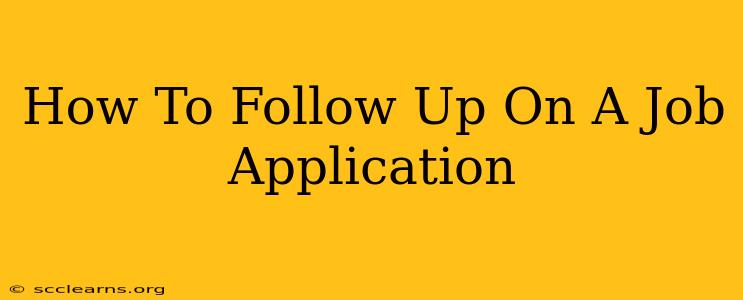Following up on a job application is crucial in today's competitive job market. It demonstrates your enthusiasm, initiative, and keeps your application top-of-mind. However, following up effectively requires a strategic approach. This guide provides you with actionable steps and best practices to ensure your follow-up maximizes your chances of landing an interview.
Understanding the Importance of Following Up
Many job seekers mistakenly believe that simply submitting their application is enough. This is a common mistake! Following up effectively showcases key qualities employers value:
- Enthusiasm: It shows you're genuinely interested in the position and the company.
- Initiative: It highlights your proactive nature and willingness to go the extra mile.
- Persistence: It demonstrates your dedication to securing the role.
- Organization: It reveals your ability to manage your job search effectively.
Ignoring the follow-up can lead to your application getting lost in the shuffle. Don't let your hard work go unnoticed!
When to Follow Up After Applying for a Job
The timing of your follow-up is critical. Too early, and you might appear overeager. Too late, and your application might be overlooked. Here's a helpful timeline:
- Initial Follow-Up: If the job posting doesn't specify a timeline, wait 5-7 business days after submitting your application.
- Second Follow-Up: If you haven't heard back after the initial follow-up, wait another 7-10 business days before sending a second, shorter follow-up.
- Beyond Two Follow-Ups: Avoid sending more than two follow-up emails unless you have specific reasons, such as attending a company event or networking with someone within the organization.
Considering the Application Method
Your follow-up strategy might need adjustments based on how you applied:
- Online Application: Stick to the email follow-up timeline above.
- In-Person Application: A phone call follow-up a week or two after applying might be appropriate, depending on the company culture.
- Networking Referral: If you were referred, check in with your contact for an update before sending a direct follow-up to the hiring manager.
How to Follow Up Effectively: Crafting the Perfect Message
Your follow-up communication should be professional, concise, and reiterate your interest. Avoid generic templates; personalize each follow-up to reflect your understanding of the role and company.
Here's what to include:
- Subject Line: Keep it brief and attention-grabbing, e.g., "Following Up: [Your Name] - [Job Title] Application."
- Opening: Reiterate your interest in the position and briefly mention your application date.
- Body: Highlight 1-2 key skills or experiences that align with the job description. Show that you've done your research on the company.
- Closing: Re-emphasize your enthusiasm and express your eagerness to learn more. Include your contact information for easy access.
Example Email:
Subject: Following Up: John Doe - Marketing Manager Application
Dear [Hiring Manager Name],
I hope this email finds you well. I am writing to follow up on my application for the Marketing Manager position, submitted on [Date]. I was particularly excited about [mention specific aspect of the job or company]. My experience in [mention relevant skill] and [mention another relevant skill] directly aligns with the requirements outlined in the job description.
I'm confident I can make a significant contribution to [Company Name]'s success. Thank you for your time and consideration. I look forward to hearing from you soon.
Sincerely,
John Doe [Phone Number] [Email Address] [LinkedIn Profile URL (Optional)]
Beyond Email: Alternative Follow-Up Methods
While email is the most common method, consider these alternatives:
- Phone Call: Use this sparingly, typically after one email follow-up, and only if you have a strong connection or the job posting encourages it.
- LinkedIn Message: A brief, professional message on LinkedIn can be a subtle but effective way to stay in touch.
Handling No Response: Graceful Rejection & Next Steps
It's possible you won't receive a response, even after following up. This doesn't necessarily mean you're not qualified. Gracefully accept the outcome and move on to your next opportunity. Analyze the process; did you miss something in your application or follow-up? What could you improve next time?
Key Takeaways: Mastering the Art of the Follow-Up
Following up on a job application is a vital step in your job search journey. By understanding the proper timing, crafting compelling messages, and utilizing various communication channels, you can significantly improve your chances of landing an interview and securing your dream role. Remember to be persistent, professional, and always show your genuine enthusiasm for the opportunity.

